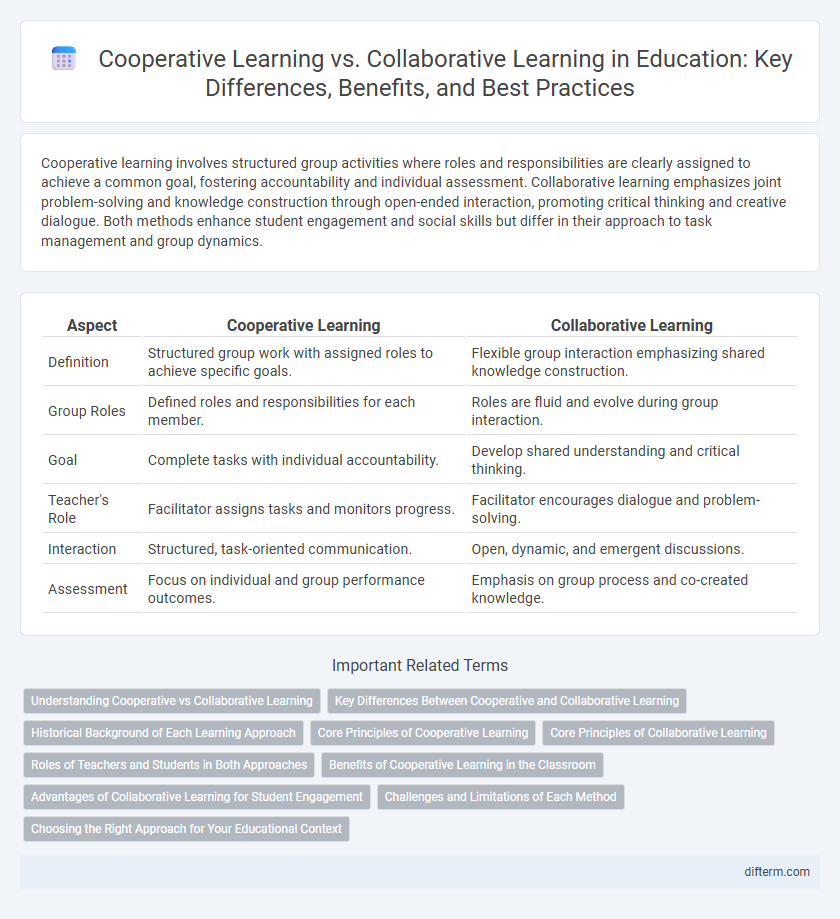Cooperative learning involves structured group activities where roles and responsibilities are clearly assigned to achieve a common goal, fostering accountability and individual assessment. Collaborative learning emphasizes joint problem-solving and knowledge construction through open-ended interaction, promoting critical thinking and creative dialogue. Both methods enhance student engagement and social skills but differ in their approach to task management and group dynamics.
Table of Comparison
| Aspect | Cooperative Learning | Collaborative Learning |
|---|---|---|
| Definition | Structured group work with assigned roles to achieve specific goals. | Flexible group interaction emphasizing shared knowledge construction. |
| Group Roles | Defined roles and responsibilities for each member. | Roles are fluid and evolve during group interaction. |
| Goal | Complete tasks with individual accountability. | Develop shared understanding and critical thinking. |
| Teacher's Role | Facilitator assigns tasks and monitors progress. | Facilitator encourages dialogue and problem-solving. |
| Interaction | Structured, task-oriented communication. | Open, dynamic, and emergent discussions. |
| Assessment | Focus on individual and group performance outcomes. | Emphasis on group process and co-created knowledge. |
Understanding Cooperative vs Collaborative Learning
Cooperative learning involves structured group tasks where students complete divided responsibilities and individual accountability is emphasized, while collaborative learning encourages shared goals and collective problem-solving without strict role assignments. Key differences include the level of interdependence and interaction, with cooperative learning often featuring assigned roles and collaborative learning promoting flexible participation. Understanding these distinctions helps educators design effective group activities that enhance student engagement and knowledge retention.
Key Differences Between Cooperative and Collaborative Learning
Cooperative learning involves structured group activities with assigned roles and individual accountability, promoting task completion through coordinated efforts. Collaborative learning emphasizes joint problem-solving and shared knowledge construction, fostering open-ended dialogue and equal participation among group members. The key difference lies in cooperative learning's focus on task division and accountability versus collaborative learning's emphasis on collective meaning-making and flexibility.
Historical Background of Each Learning Approach
Cooperative learning emerged in the 1960s as an educational approach rooted in social interdependence theory by Morton Deutsch, emphasizing structured group tasks and assigned roles to enhance individual accountability and collective success. Collaborative learning has its origins in Vygotsky's sociocultural theory from the early 20th century, focusing on knowledge construction through shared dialogue and group problem-solving without fixed roles. Both approaches evolved through educational reform movements aiming to promote active student engagement and critical thinking in classroom environments.
Core Principles of Cooperative Learning
Cooperative learning centers on structured group activities where students work together to achieve shared academic goals, emphasizing positive interdependence, individual accountability, and face-to-face promotive interaction. Core principles include clearly defined roles, group processing to evaluate teamwork, and development of social skills to enhance communication and conflict resolution. This approach contrasts with collaborative learning by prioritizing teacher-assigned tasks and assessment criteria that ensure each member contributes to the group's success.
Core Principles of Collaborative Learning
Collaborative learning centers on shared intellectual effort, where students engage in group discussions, problem-solving, and knowledge construction by leveraging diverse perspectives. Core principles include mutual interdependence, individual accountability, and the development of social skills, fostering a supportive environment for collective success. Emphasis on dialogue and negotiation distinguishes collaborative learning from cooperative learning's structured task division, enhancing deeper understanding and critical thinking.
Roles of Teachers and Students in Both Approaches
In cooperative learning, teachers assume the role of facilitators by assigning specific roles to students and structuring tasks to ensure individual accountability, while students actively engage by fulfilling assigned responsibilities to achieve shared goals. Collaborative learning emphasizes a more flexible teacher role as a guide or co-learner, encouraging students to collectively construct knowledge through open dialogue and mutual problem-solving without predetermined roles. Both approaches require active student participation, but cooperative learning relies on clearly defined roles, whereas collaborative learning fosters spontaneous interaction and shared leadership among students.
Benefits of Cooperative Learning in the Classroom
Cooperative learning enhances student engagement by promoting structured group interactions where roles and responsibilities are clearly defined, leading to improved academic achievement and accountability. This approach fosters critical social skills such as communication, conflict resolution, and teamwork, which are essential for future professional environments. Research indicates that cooperative learning environments increase retention of knowledge and encourage positive attitudes towards learning compared to individualistic instructional methods.
Advantages of Collaborative Learning for Student Engagement
Collaborative learning enhances student engagement by promoting active participation and fostering communication skills within diverse groups. It encourages critical thinking and problem-solving through shared responsibility and peer-to-peer interaction. This approach creates a dynamic learning environment that motivates students to contribute meaningfully and retain information effectively.
Challenges and Limitations of Each Method
Cooperative learning often faces challenges such as unequal participation and dependency on designated roles, which can limit individual accountability and hinder deep understanding. Collaborative learning struggles with potential conflicts due to diverse perspectives and requires strong communication skills to avoid misunderstandings and ensure effective teamwork. Both methods demand careful facilitation to balance group dynamics and maximize educational outcomes in diverse classroom settings.
Choosing the Right Approach for Your Educational Context
Cooperative learning structures tasks with clearly defined roles and responsibilities, promoting individual accountability and measurable outcomes, making it ideal for contexts requiring structured guidance and assessment. Collaborative learning emphasizes joint problem-solving and shared knowledge construction, fostering creativity and critical thinking, suitable for environments that value open-ended exploration and peer interaction. Educators should align their choice with curricular goals, student dynamics, and the desired balance between individual accountability and collective engagement.
Cooperative Learning vs Collaborative Learning Infographic

 difterm.com
difterm.com